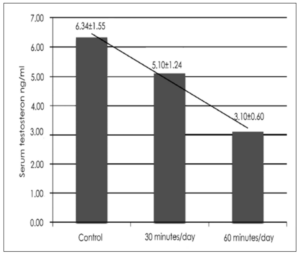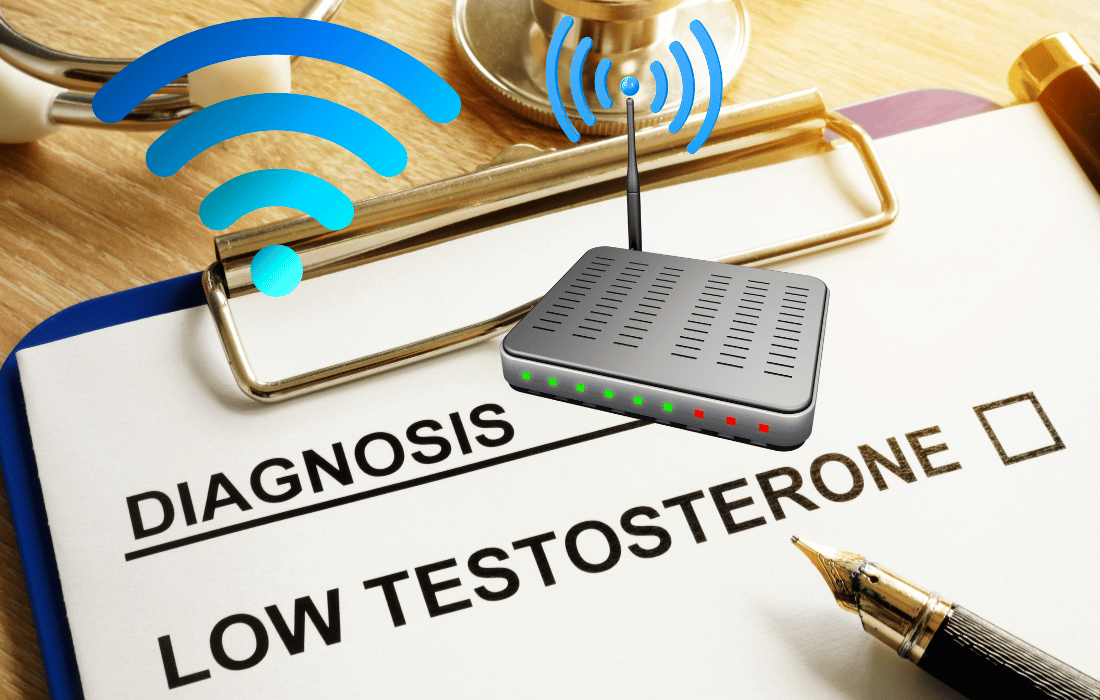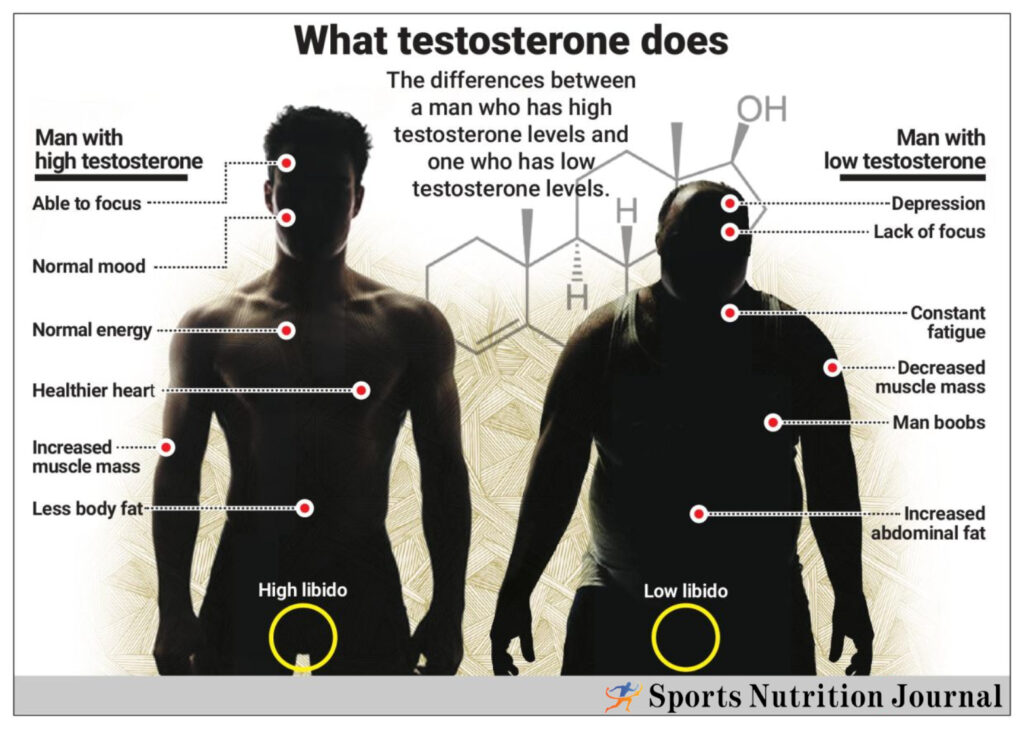Athletes spend hours perfecting their craft, focusing on everything from strength training to conditioning, nutrition to recovery. Yet, there’s a silent disruptor in their environment that most aren’t considering—EMF (electromagnetic fields). We’re not just talking about the latest health fad; this is serious, and it directly affects one of the most critical hormones for peak athletic performance: testosterone.
The connection between EMF and testosterone isn’t mainstream knowledge, but the emerging research on this topic is enough to make any athlete sit up and take notice. Testosterone is crucial for physical performance, recovery, muscle building, and even mental resilience. So, if you’re an athlete who spends countless hours optimizing every aspect of your life, understanding how EMF might be affecting your testosterone levels is key.
The Role of Testosterone in Athletic Performance
Testosterone isn’t just the “manliness” hormone—although it certainly plays a major role in defining secondary male characteristics. It’s a vital hormone for both men and women. For athletes, testosterone is directly tied to muscle growth, recovery, and maintaining high energy levels during rigorous training. Testosterone affects more than just the physical—it’s also essential for maintaining cognitive function, motivation, and focus. Whether you’re in a high-stakes competition or pushing through the last grueling rep at the gym, your body relies on testosterone to perform optimally.
In men, testosterone levels begin to naturally decline after the age of 30. This is part of the aging process, but for athletes, particularly those involved in high-performance sports, the decline of testosterone can lead to muscle loss, increased body fat, lower energy levels, and slower recovery times. For women, testosterone is still important for muscle mass and energy, though in much lower quantities. This hormonal balance is what keeps the body in a state of peak performance.
But what happens when an external factor—like EMF exposure—starts to mess with your testosterone production?
The Emerging Research on EMF and Testosterone
In the last decade, there’s been an increasing focus on how EMF exposure may be contributing to a wide range of health concerns, particularly in the realm of hormone disruption. Recent studies show a concerning link between EMF and testosterone levels, especially when exposure is long-term. The cumulative effect of our constant contact with cell phones, Wi-Fi routers, smartwatches, and even Bluetooth headphones may be contributing to a hidden decline in testosterone—a hormone that’s already on the decline due to other factors like aging and stress.
One study, published in the Asian Pacific Journal of Reproduction, specifically explored how prolonged exposure to low-frequency EMF affects testosterone production. It found that not only did testosterone levels drop, but the structural integrity of the seminiferous tubules—where sperm and testosterone are produced—was also compromised. This means that EMF isn’t just interfering with testosterone production on the surface; it’s causing deep cellular disruptions that could have long-lasting effects on reproductive health and performance.

Moreover, research involving animal models shows that exposure to radiofrequency electromagnetic radiation from devices like cell phones led to a reduction in serum testosterone levels. For athletes who often carry their phones in their pockets or have them within close proximity during training, this is an alarming concern. Given the proximity of phones to the reproductive organs, it makes sense that over time, exposure could affect testosterone production.
EMF-Induced Oxidative Stress: A Silent Testosterone Killer
One of the main mechanisms through which EMF exposure disrupts testosterone is by inducing oxidative stress. Oxidative stress occurs when there’s an imbalance between free radicals and the body’s ability to detoxify them. Free radicals cause cellular damage, and in the case of testosterone production, they disrupt the function of the Leydig cells in the testes, which are responsible for producing testosterone.
When Leydig cells are under oxidative stress, they are less capable of maintaining normal testosterone production. Additionally, oxidative stress can weaken the blood-testis-barrier: a protective layer that guards reproductive organs from toxins. When this barrier is compromised, the testes are more susceptible to harmful external factors, which can further reduce testosterone levels.
In a study published in The International Journal of Environmental Research and Public Health, it was found that Leydig cells exposed to continuous EMF radiation for 24 hours showed signs of inhibited testosterone production. Researchers observed that EMF exposure caused changes in cell cycle distribution, meaning that Leydig cells were less capable of reproducing and maintaining healthy testosterone levels. This research highlights the direct impact of EMF on testosterone-producing cells and raises the alarm for athletes who are constantly exposed to wireless devices.
Testosterone and the Hypothalamic-Pituitary-Gonadal Axis
EMF doesn’t just affect testosterone at the cellular level. It also impacts the hypothalamic-pituitary-gonadal (HPG) axis, which is a key regulatory system governing hormone production, including testosterone. The HPG axis is responsible for signaling the release of luteinizing hormone (LH), which then stimulates the production of testosterone in the testes. When the HPG axis is disrupted by EMF exposure, it can throw off this delicate balance, leading to decreased testosterone levels over time.
In particular, studies have suggested that EMF exposure may alter the way the hypothalamus and pituitary gland communicate, disrupting the normal hormone cascade that controls testosterone production. This disruption can have far-reaching effects on athletic performance, energy levels, and overall hormonal health.
For athletes, maintaining a healthy HPG axis is crucial, as even minor imbalances can have significant impacts on performance and recovery. If EMF exposure is throwing this system out of balance, the long-term implications for athletes could be substantial.
Real-World Impacts of EMF on Athletes
Let’s face it: modern athletes rely heavily on technology. Whether you’re wearing a fitness tracker to monitor your heart rate, streaming music through Bluetooth headphones during a workout, or checking your progress on your smartphone, you’re constantly exposed to EMF. This exposure is happening day in and day out, often without any thought to the potential consequences.
Consider the fact that most men carry their phones in their pockets for hours on end. Your phone is constantly emitting EMF, and it’s usually positioned right next to your reproductive organs. Over time, this proximity can have a significant impact on testosterone production. The testes, which are responsible for producing testosterone, are highly sensitive to environmental factors—and EMF is no exception.
Then there’s the gym. Wi-Fi is omnipresent in most training environments. Bluetooth devices, from wireless earbuds to smartwatches, further contribute to the EMF load athletes are exposed to during their workouts. While technology has made training more efficient and data-driven, it also exposes athletes to potentially harmful radiation on a near-constant basis.
How EMF-Induced Low Testosterone Affects Performance
Low testosterone doesn’t just affect your ability to bulk up or maintain muscle mass; it has far-reaching implications on virtually every aspect of athletic performance. Here’s a breakdown of how EMF-induced low testosterone could be impacting you as an athlete:
1. Reduced Muscle Mass and Strength
Testosterone plays a direct role in muscle protein synthesis, the process your body uses to repair and grow muscle after exercise. Lower testosterone levels mean your muscles can’t repair as quickly or efficiently, leading to slower recovery times and less muscle growth.
2. Slower Recovery
Recovery is critical for athletes, especially those who train at a high intensity. Testosterone helps regulate the body’s recovery processes, and reduced levels can lead to prolonged recovery times, increasing the risk of overtraining and injury.
3. Increased Fatigue
Athletes often push their bodies to the limit, and maintaining high energy levels is key to performance. Low testosterone can lead to increased feelings of fatigue, making it harder to sustain high-intensity workouts and competitions.
4. Decreased Mental Focus and Motivation
Testosterone isn’t just a physical hormone—it’s crucial for mental focus and drive. Lower levels can lead to reduced motivation, mood swings, and difficulty maintaining the mental edge needed for top-level athletic performance.
Practical Steps to Mitigate EMF Exposure
Reducing EMF exposure is easier said than done, especially in today’s hyper-connected world. However, there are practical strategies athletes can implement to minimize the impact of EMF on their testosterone levels:
1. Keep Your Phone Away from Your Body
Avoid carrying your phone in your pocket or placing it near your reproductive organs for prolonged periods. If you must carry it, consider using a radiation-blocking case or switching your phone to airplane mode to reduce EMF exposure.
2. Use Speakerphone or Wired Earphones
Bluetooth headphones may be convenient, but they also expose you to additional EMF. Opt for wired earphones or use the speakerphone function when making calls to keep your phone away from your body.
3. Optimize Your Sleep Environment
Your body recovers during sleep, and reducing EMF exposure at night is critical for overall recovery and hormonal balance. Keep your phone out of the bedroom, turn off Wi-Fi routers, and consider using an EMF protection device from Aires Tech to create a safer sleep environment.
4. Get Grounded
Spending time in nature and grounding—walking barefoot on grass, dirt, or sand—can help reduce the effects of EMF exposure. Grounding has been shown to improve the body’s ability to handle oxidative stress, which can mitigate the impact of EMF on testosterone production.
5. Use Aires Tech EMF Protection
For athletes constantly exposed to EMF, using technology like Aires Tech’s EMF protection devices can be a game-changer. Aires Tech products are designed to modulate and reduce the harmful effects of EMF, helping protect your testosterone levels and overall health without compromising your tech-driven lifestyle.
Aires Tech: A Proven Solution for Athletes

Aires Tech is at the forefront of creating EMF protection devices that help athletes reduce their exposure without compromising their use of technology. For athletes constantly surrounded by wireless devices, it’s virtually impossible to eliminate all EMF exposure—but Aires Tech offers a reliable solution. Their products, using patented technology, help to modulate and neutralize the harmful effects of EMF on the body.
Aires Tech devices don’t block EMF but rather work to reduce its biological impact through modulating the waveforms. This is crucial for athletes who rely on technology for training, recovery, and performance tracking. Their devices have been tested and proven to reduce EMF-induced oxidative stress and hormonal disruption, making them a must-have for any athlete serious about protecting their testosterone levels and overall health.
For instance, athletes who regularly carry smartphones or use Bluetooth devices can use Aires Tech’s compact EMF protection products like the Aires Lifetune One. This small device can be attached directly to phones or other electronic gadgets, helping to reduce the amount of radiation emitted by these devices. For those looking to protect their homes or gyms, Aires Tech also offers larger devices like the Aires Lifetune Zone Max, which works to neutralize EMF exposure in larger environments.
With Aires Tech, you get to have the best of both worlds: staying connected through your essential devices while protecting your body from the damaging effects of EMF exposure.
Conclusion: Safeguard Your Testosterone and Athletic Future
As athletes, we do everything in our power to optimize performance and maintain peak physical condition. However, the modern world has introduced an invisible threat—EMF exposure—that is silently chipping away at one of the most critical hormones for performance: testosterone. Studies consistently point toward a disturbing connection between EMF exposure and reduced testosterone levels, highlighting oxidative stress, cellular disruption, and the imbalance of the HPG axis as potential culprits.
By taking proactive steps to minimize EMF exposure—like keeping phones out of your pockets, using wired headphones, and optimizing your sleep environment—you can make a significant difference in protecting your testosterone levels. But when it comes to full EMF protection, Aires Tech provides a scientifically proven method to safeguard your health.
The world of athletics is more competitive than ever, and optimizing every aspect of performance is crucial to staying ahead. By addressing the often-overlooked impact of EMF on testosterone and utilizing solutions like Aires Tech, athletes can ensure they’re not leaving any stone unturned when it comes to protecting their bodies and performance.
Testosterone is your body’s natural performance enhancer—don’t let EMF take that away.








